by Ariane ~ October 19, 2015
 Here is my new perpetual calendar featuring Monet’s house and gardens at Giverny.
Here is my new perpetual calendar featuring Monet’s house and gardens at Giverny.
I have carefully selected my best photos among thousands of pictures I’ve taken over the past years in the famous painter’s gardens.
The shots follow the seasons. Page after page, day after day, you see how spring arrives and settles, gets to its glory, turns into summer and its plenty, until autumn comes with more flowers than ever and fabulous colors reflecting into the pond.
Winter has unexpected delights to offer, for instance the garden covered with snow, the frozen pond, or gorgeous sunrises over the Seine.
To make sure the new picture is a new surprise every day, landscape views alternate with flowers close ups, streets of Giverny with details of the house decoration, and more.
Each picture has a caption in English and in French.
The calendar has been designed and printed in France by a nature-friendly manufacturer.
The size is 15×12 cm, (4.7′ x 5.9′) including a white stripe at the bottom for your notes.
The price is 19 euros. I am happy to ship worlwide for an extra cost of 3.5 euros. For instance, total cost for the United States is 25 US$, or 17 £ for Great Britain, or 34 CAD, shipment included.
To order, just leave a comment and I will get in touch with you. Imagine this little window with lovely garden pics next to your computer or on your kitchen counter or anywhere else, like a breeze of fresh air…
by Ariane ~ October 4, 2015

At Giverny in Rue Claude Monet, one of the mail boxes to send letters and postcards is located amid flowers.
In October, the helianthus are big enough to reach the height of the mail box.
Their yellow hues match the official color of La Poste boxes.
Having to make your way through the flowers to post your mail makes paying the bills just a little more fun.
by Ariane ~ September 16, 2015
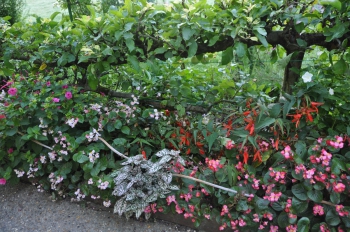 In Monet’s flower garden at Giverny, a beautiful border covers the feet of the espaliered apple trees.
In Monet’s flower garden at Giverny, a beautiful border covers the feet of the espaliered apple trees.
These colorful cushions are made of begonias boliviensis, whose lovely leaves resemble angel wings, combined with pink begonias semperflorens, four o’clock plants and polka dot plants.
The latter is often used in planters but it is also a very nice ground cover, that brings color and doesn’t need deadheading.
According to a keen gardener I met, polka plants are ‘the best thing since sliced bread’. It was the first time I ever heard this funny expression that doesn’t translate into French. Well, you can translate word for word, but it is not a colloquialism and I can’t think of any equivalent.
This is great with foreign languages: you keep learning as long as you talk with native speakers, and sometimes you remember how it felt when you were six and wouldn’t understand exactly what people meant.
And this is what I find so great with my job: sharing with avid gardeners, speaking foreign languages, meeting wonderful people, and walking daily in the little Eden designed by Monet. All this combines like the flowers in the flower bed and makes my life happy and colorful. Thank you to you all.
by Ariane ~ August 9, 2015
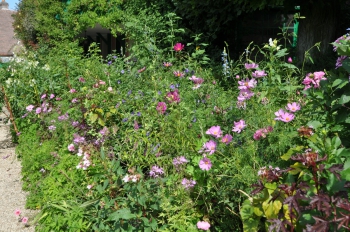
A flower hedge at the edge of Monet’s garden
For a French tongue, pronouncing the English words starting with an h is not that easy. The French language doesn’t have this sound, thence it is a special effort to say these words right. I do my utmost. I apply myself. I concentrate. I don’t mix up edges and hedges, ear and hear.
Today however, at the end of my tour in Monet’s garden, a gentleman came to me. He told me that there is a word that comes several times in my commentary that I didn’t say right: heir. Monet’s heir, his son Michel. As a lawyer, he explained, it is a word he knows only too well. It is not like the hair, but like the air.
Wow. Isn’t it disconcerting? I expected exactly the contrary, that I had forgotten the h. I was very grateful, because it was done with kindness. It felt like receiving a little gift.
My English has improved a lot since school, thanks to the native speakers I meet every day. But very few take the trouble to correct me. I suppose a certain quantity of mistakes is acceptable, just like for you when reading this blog. I’ve improved because I paid attention to the right phrases, grammar, or pronunciation of my interlocutors. But I never realized this very mistake, although lots of visitors have asked me about Monet’s heirs. Because it is not relevant in French, I didn’t notice that the h was missing.
by Ariane ~ August 2, 2015

When there is no wind at all, the water lilies painted by Monet at Giverny seem to be floating in the air.
The surface of the pond is such a perfect mirror that the water turns invisible.
The rafts of water lilies resemble flying carpets en route for a long trip to mysterious countries.
by Ariane ~ June 30, 2015
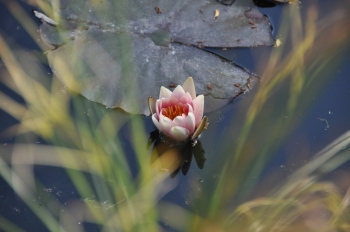
Claude Monet was never tired of painting his water lilies, because they are ever changing. They open, they close, they float on a mirror that reflects the clouds passing, the sun getting higher and lower in the sky. Monet painted his water lilies relentlessly, almost 300 times.
It is a question that visitors I guide through the gardens ask regularly: “Do you ever get tired of it?” No, never. How could one get tired of beauty?
by Ariane ~ June 17, 2015
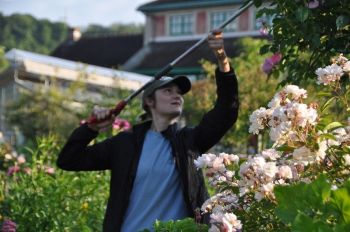
As early as 7 o’clock in the morning, the fairies are at work in Monet’s gardens. Young volunteers carefully take away the wilted flowers to keep the garden full of beautiful blossoms. Climbing roses are reached thanks to secateurs with long handles that need some practice and a lot of attention. The volunteers also have many other tasks to do. Here is Hillary Bernhardt, who was kind enough to answer a few questions:
Do you like this work?
Yes, very much. It’s very special to be able to work in Monet’s garden for a month. I have the opportunity to see how the flowers change in the garden as we take certain flowers out and put new ones in or as new ones pop out of the ground. I feel lucky to be able to soak in the garden’s beauty each day. Additionally, I love the opportunity to visit the garden after hours. It is sometimes challenging to be working outside all day, but I am thankful for the opportunity.
What made you want to apply?
I knew previous students from Davidson College who had completed the internship and they had all loved the experience. It’s a great way to practice speaking the French language, experience French culture, and explore the region on weekends. It’s also an excellent way to reflect on one’s life and journey thus far. As I’m working in the garden or going on bike rides in the area, I have the space to think about what has been meaningful in my life so far and what I would like to do in the future.
How is the atmosphere?
Working in the garden is fun! I enjoy talking to the tourists, especially when I’m able to practice French with them. Many of them ask me for the names of the flowers, but usually they know more of the names than I do! Also it has been enjoyable getting to know the professional gardeners, who really make the magic happen in the garden. I’ve enjoyed joking around with them as I have gotten to know them better.
by Ariane ~ June 13, 2015

Over the main alley that crosses Monet’s garden, the climbing roses display their tender colors in June.
Their pink and red match the pretty colors of the annual poppies scattered everywhere in the flower beds.
(click to enlarge)
by Ariane ~ June 10, 2015
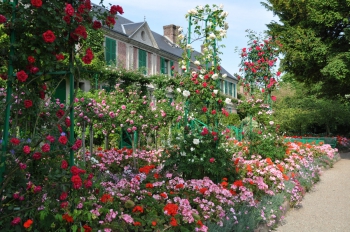
I hope I will live long enough to experience the time when computers will manage to send fragrances. It would be so nice to be able to share the scents of Giverny. The roses are in full bloom, and their delicate perfume fills in the air. In the water garden, it mingles with the sweet scent of honey suckle, creating a very girly combination, the kind of fragrance I loved to wear as a teenager. I wonder if the teenagers of today still like it. But I see everyday how ladies love smelling flowers. To get most of a peony or an iris, the best is to put one’s nose in the petals. It is so good it gets addictive. Is this a feminine gesture, as a female visitor suggested it to me? I remember a photo of Georges Clemenceau smelling a rose. The Tiger himself! With such an example, gentlemen should feel free to indulge in this pleasure.
by Ariane ~ May 25, 2015
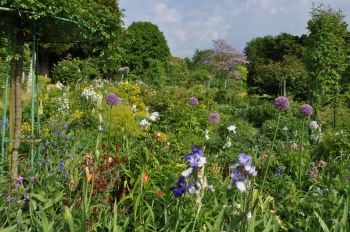
In May, a big tree crowns Monet’s flower garden with a beautiful mauve blossom. It is a paulownia, also named princess tree or impress tree. Its color harmonizes with the purples of the alliums in the Norman Enclosure. They combine with the yellows of isatis, their complementary color, for more vibrance.
There is even a more subtle combination. The paulownia is so big that it can be seen from the water garden. It reflects into the pond between the reflections of the wisterias on both sides of the pond. They have exactly the same color and flower the same two weeks, as if they would have organized their annual meeting. Thus they create a connection between the two gardens separate by the road.
by Ariane ~ May 19, 2015
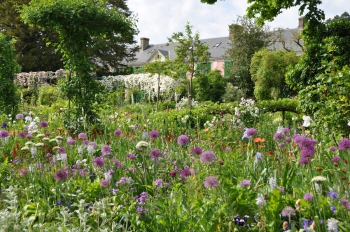
Mid-May, in Monet’s gardens the last tulips that were so colorful are followed by blue and purple flowers: flouncy irises and ball shaped alliums.
Both exist in all sorts of tones from pale to intense.
When planting them, the gardeners pay great attention to their variety, trying not to have two same flowers side by side.
Although they are so numerous, they never produce a mass effect but keep a very natural look, that makes all the charm of Giverny.
by Ariane ~ May 18, 2015
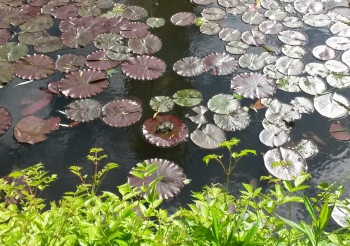
Claude Monet’s water lily pond in May, when frogs croak and sit on pads…
The first Nympheas have opened! They will flower until September.
I’m grateful to the kind visitor that quoted the above title, and then patiently explained to me the related colloquialism and thus the joke. In French we don’t have the same image. We say that time passes in a lightning, le temps passe en un éclair. The way each language expresses reality and experiences its own way is an endless source of amazement and amusement to me.
by Ariane ~ April 25, 2015
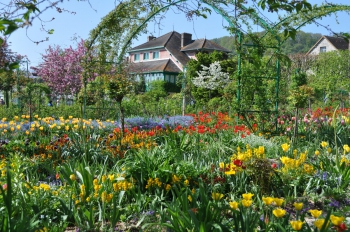
Seen on a map or from the windows of his home, Monet’s flower garden aligns straight lines that ressemble almost a grid. But because Monet raised the flower beds, an oblique look through the garden doesn’t reveal the walkways. Instead, it gives the feeling of an endless flowered meadow full of striking colors. Blues are made by forget-me-not, while tulips, fritillaries and pansies provide all the colors of the painters palette. (Click on picture to enlarge)
by Ariane ~ April 11, 2015
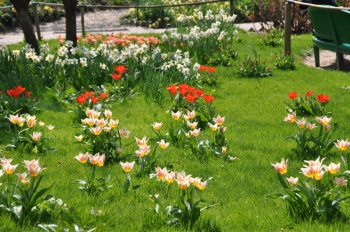
In April, as soon as the sun shines, Monet’s garden radiates. The colors are brighter than ever. Greens are vibrant. Red tulips flame in their complementary color. All the upside down bells of the bulb flowers resemble shiny laterns that have just been switched on.
What is the reason therefore? A freshly washed air, cool enough not to contain any haze? Or is it due to the height of the sun? I don’t know. But it is properly amazing and special to early spring. The glow of April makes you want to come out in the garden, to paint and to photograph.
by Ariane ~ March 29, 2015
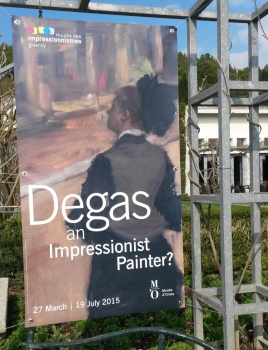 A beautiful exhibition has just started at the Museum of Impressionisms Giverny. Through 80 works signed Edgar Degas, (oil on canvas, pastel, brass, etc) it questions the painter’s membership in the group of the impressionists. His daring compositions, his motifs taking in the present day life, his free brushwork, last but not least his involvement in the organization of the impressionist exhibitions of the times make him an impressionist.
A beautiful exhibition has just started at the Museum of Impressionisms Giverny. Through 80 works signed Edgar Degas, (oil on canvas, pastel, brass, etc) it questions the painter’s membership in the group of the impressionists. His daring compositions, his motifs taking in the present day life, his free brushwork, last but not least his involvement in the organization of the impressionist exhibitions of the times make him an impressionist.
But Degas rejected open air painting, had a classical training, and hated the word impressionist itself. So was he, or not, an impressionist painter? Make your own opinion exploring this outstanding exhibition that displays many famous masterpieces, as well as less known works uncluding rarely seen Degas landscapes.
MDIG, 27 March-19 July 2015 More information
 Here is my new perpetual calendar featuring Monet’s house and gardens at Giverny.
Here is my new perpetual calendar featuring Monet’s house and gardens at Giverny.












